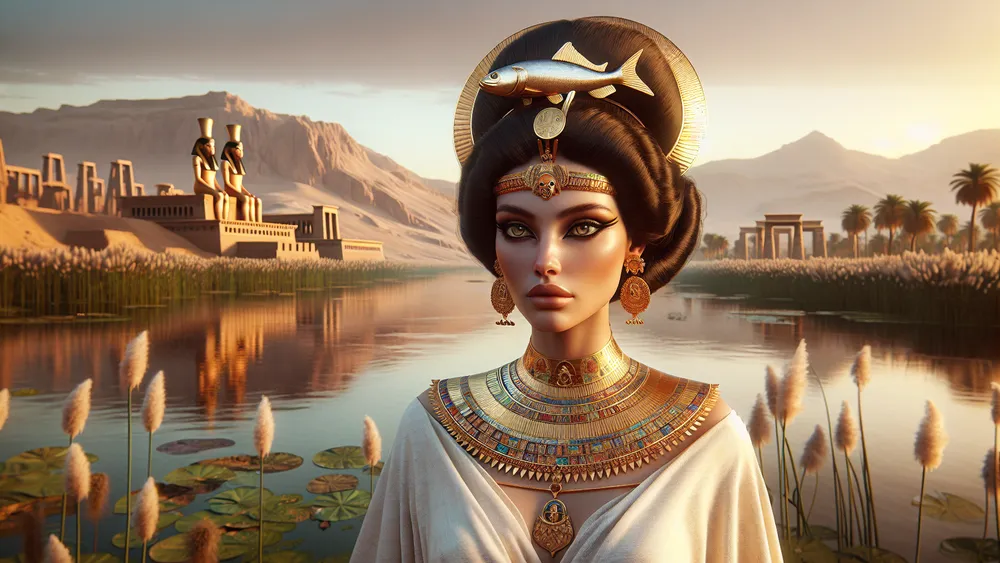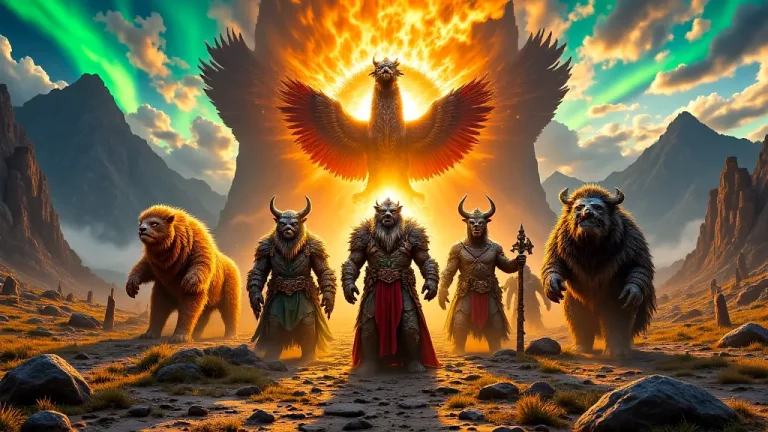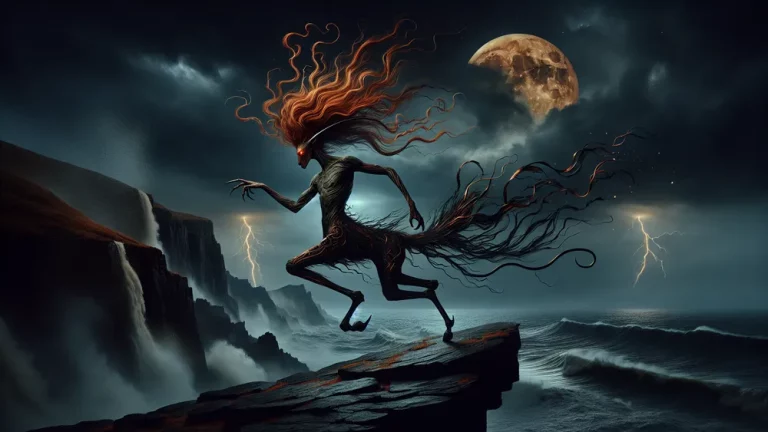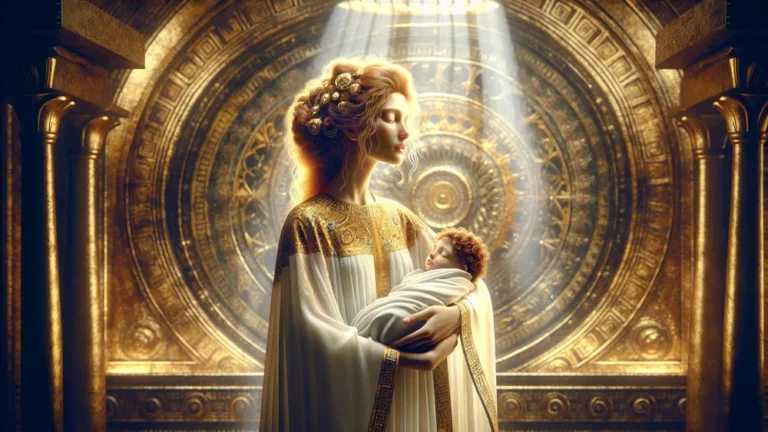Hatmehit: Ancient Egyptian Goddess Of The Nile Delta
When you think about old Egyptian stories, names like Ra, Osiris, and Isis might pop up. But the group of Egyptian gods is pretty big and also has many lesser-known but just as interesting figures. One such god is Hatmehit, the old Egyptian goddess of the Nile Delta.
Key Points:
- Hatmehit is an ancient Egyptian goddess of the Nile Delta.
- Her name means Foremost of the Fish in old Egyptian language.
- She is connected with fertility, abundance, and the life-giving properties of the Nile.
- Hatmehit was worshipped mainly from the Old Kingdom through the Ptolemaïc period.
- She was primarily worshipped in Mendes, a city in the northeastern Nile Delta.
- Hatmehit is often represented in art as a woman with a fish symbol on her head.
- Her symbols include fish, the Nile tilapia, a stick, and the Ankh symbol.
See her as someone guarding the waters, much like how a lighthouse keeper keeps an eye on the sea and ensures safety and prosperity for those who need the river. This blog post will look into where Hatmehit came from, her history, and why she is important, including her pictures in art, her place in stories, and how people worshiped her.
Whether you like stories about gods or are just curious, this guide will shed some light on the life and legacy of this interesting goddess.
Hatmehit: Overview and Key Facts
| Key Point | Description |
|---|---|
| Name | This goddess named Hatmehit (also spelled Hatmehyt) |
| Meaning of Name | “Foremost of the Fish” |
| Role | She is the Goddess of the Nile Delta, and she protects fish and fishermen |
| Symbols | Fish, especially the Nile tilapia |
| Primary Worship Center | Mendes (modern-day Tell El-Rub’a) |
| Depictions | Depictions points out her as a woman with a fish symbol on her head |
| Historical Period | Worshipped mainly during the Old Kingdom through the Ptolemaïc period |
| Significance | Connected with fertility, abundance, and the life-giving properties of the Nile |
| Related Deities | Connected with Banebdjedet, a ram god, often seen as his partner |
| Archaeological Findings | Items and inscriptions that were found in Mendes and other Delta places |
The Beginnings of Hatmehit
To really understand how critical Hatmehit is, we need to first look at where her name comes from and what was happening when people started worshiping her. This is key.
Name Origins and Meaning
The name “Hatmehit” comes from the old Egyptian language, where “Hat” means “main” and “mehit” means “fish.” So, the name means “Main of the Fish.” In Egyptian stories, this title indicates her main association with fish and the life-bringing waters of the Nile. Like a modern title such as “Chief Executive Officer” points out a leadership position, “Hatmehit” indicates her important position in the water world.

In Egyptian stories, names were more than just labels but held the nature and power of the god. Therefore, Hatmehit’s name presents her standing as a protector and giver, essential to the growth and plenty brought by the Nile.
- Hat: Main, indicating a position of leadership.
- Mehit: Fish, pointing out her rule over water life and the Nile.
Hatmehit’s name in old Egyptian language means Main of the Fish, symbolizing her importance as a protector and giver of life through her association with water and the Nile.
History and Background
Hatmehit’s worship goes back to the Old Kingdom period of ancient Egypt, from around 2686–2181 BCE, and went on through the Ptolemaïc time, lasting until 30 BCE. Her main worship center was in Mendes, found in the northeastern Nile Delta. This place was very fertile and relied on the Nile’s things. Therefore, a god that had to do with fish and water was very vital.
Modern cities have figures that represent their identity, so Mendes saw Hatmehit as a protector and giver. She became more significant in other parts of the Delta over time, indicating how she became more central in the ancient Egyptian religious scene. Important archaeological findings have given us information about Hatmehit’s worship. Digs in Mendes found many items like statues, amulets, and writings dedicated to her.
These finds are proof of people worshipping her and give us ideas about the rituals and offerings for her. For instance, fish-shaped charms and images of Hatmehit with a fish symbol on her head have been found, stressing her link with water life.
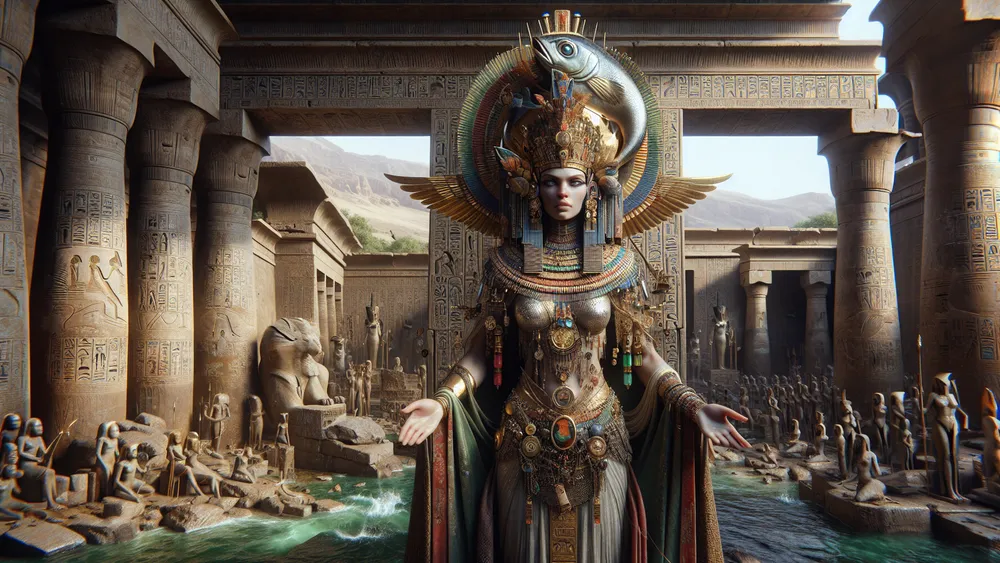
Plus, ruins of temples in Mendes points out big buildings made for her, similar to how modern monuments honor key figures. These finds help us understand the rich set of religious practices around Hatmehit.
- Old Kingdom Period: 2686–2181 BCE
- Primary Cult Center: Mendes in the Nile Delta
- Archaeological Findings: Statues, amulets, inscriptions, and temple remains
Imagery and Symbols
To completely understand Hatmehit’s part in old Egyptian culture, it is important to look at how she was indicated in art and the symbols that go with her.
Ancient Art Depictions
In old Egyptian art, Hatmehit was many times indicated as a woman with a fish mark on her head, which points outs her control over water animals and her link to the Nile. There is this fish mark that is often seen in many things like statues, carvings, and charms, like how modern logos stand for brands.
The fish, a sign of growth and plenty, points out her part as a giver and protector of the Nile’s goods. Further, some pictures shows her with a stick or a key of life, making more clear her divine authority and her life-giving powers.
These art pieces do not only indicate her place in the group of gods but also stand as a look at her safe and caring nature.
- Fish Mark: Shows her control over water animals and link to the Nile.
- Stick: Stands for divine authority.
- Key of Life: Shows life and growth.
Symbol Meaning and Features
Hatmehit’s traits are full of symbolic value, each that presents her godly roles and strengths. The fish mark on her head points out growth, plenty, and her control over the Nile’s fish life. This is like how a cornucopia points out plenty in much the same way.
The stick she often holds presents her divine authority and rule, like how a crown presents a king or queen’s power. The ankh, which looks like a cross with a loop at the top, is a strong sign of life and never-ending life. This makes clear her part as a giver of life and protector.
These signs all point out her role in making sure the Nile gives plenty and growth.
| Symbol | Meaning |
|---|---|
| Fish Mark | Growth, plenty, control over fish life |
| Stick | Godly control and rule |
| Ankh | Life and never-ending life |
Her Role in Egyptian Stories
After looking at Hatmehit’s images and signs, let’s now see her part and importance within the many Egyptian stories.
Hatmehit in the Pantheon
Hatmehit had a big part in the Egyptian group of gods, mainly as a goddess connected with the Nile Delta and its waters that give life. Her position was well-known in the city of Mendes, where people respected her as a local deity. It is interesting that her links to other gods and goddesses made her even more vital.
For instance, she was often tied to Osiris, the god of the afterlife, and Isis, the goddess of magic and motherhood, making a group of three gods that presented her caring and protective traits. These links are like how key people in a family or group help and boost each other’s roles.
- Part: Goddess of the Nile Delta, tied to growth and plenty.
- Position: Well-known in Mendes, respected as a local god.
- Links: Tied to Osiris and Isis, making a group of three gods.
Hatmehit played a crucial role as a goddess of the Nile Delta, closely linked to growth and abundance, especially in Mendes, where she was highly respected and connected to Osiris and Isis, forming a trio that showcased her nurturing and protective characteristics similar to a supportive family unit.
Myths and Tales
Hatmehit appears in several myths and stories that indicate her importance in the Egyptian pantheon. One well-known story includes her part in the Osirian myth cycle, where she is often presented as a caring figure who helps bring Osiris back to life. This myth presents her link with life, growth, and the repeating nature of being alive.
It is interesting that in some versions of the story, Hatmehit turns into a fish to get the cut-up pieces of Osiris’s body from the Nile, presenting her strong connection to the river and its life-giving features. Another well-known story includes Hatmehit’s link with the city of Mendes, where people respected her as a local deity.
In this story and place, she is often shown as the partner of Banebdjedet, the ram-headed god of growth and strength. Their union was believed to make sure the land is successful and fertile, like how a good partnership today can help both grow and succeed.
These stories not only point out her importance in the local religious ways but also reflect her larger role in the Egyptian view of life, end, and rebirth.
- Osirian Myth Cycle: Hatmehit helps bring Osiris back to life, indicating life and growth.
- Turning into a Fish: Gets Osiris’s body pieces from the Nile, presenting her link to the river.
- Partner of Banebdjedet: Makes the land successful and fertile in Mendes.
Worship Practices
After we have looked at the myths and stories about Hatmehit, let’s shift our focus to how she was honored and the rituals for her in ancient Egypt.
Worship Centers
Hatmehit’s worship was mainly in the city of Mendes, located in the Nile Delta. The city was not only an essential religious hub but also an significant place for trade because of being near the river. It is interesting that the main temple dedicated to Hatmehit in Mendes was a grand structure, decorated with carvings and statues presenting her in different forms, often with symbols of growth and plenty.
The temple was a place for religious activities and community gatherings much like how modern-day buildings or centers are used. Additionally, smaller shrines dedicated to Hatmehit could be found throughout the Delta region, each presenting people’s admiration for her.
- Main Worship Place: Mendes, an vital religious and economic hub.
- Main Temple: Grand structure with carvings and statues.
- Small Shrines: Found all over the Delta region, indicating widespread admiration.
Rituals and Offerings
Rituals and offerings for Hatmehit were essential to her worship, presenting the deep respect her followers had. Interestingly, fish were often used as offerings, and they showed her link to the Nile and its resources. Typically, rituals included prayers, hymns, and burning of incense to ask for her blessings of growth and plenty.
In ancient Egypt, these practices kept the balance of Ma’at, the cosmic order. They were believed to ensure the ongoing wealth of the land and people.
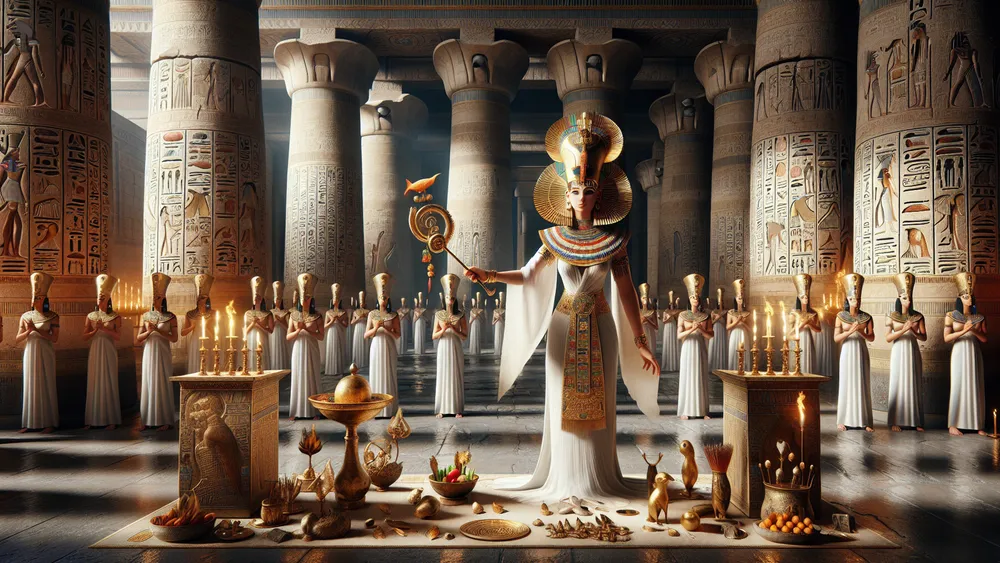
- Offerings: Fish, presenting her link to the Nile.
- Rituals: Prayers, hymns, and burning of incense.
- Importance: Maintaining Ma’at and ensuring prosperity.
Modern Views and Influence
After we looked into the old rituals and offerings for Hatmehit, now we will see how she is shown in modern culture.
Hatmehit Today
Even if she is an old god, Hatmehit is still found in modern stuff. In books and art, she is often mentioned, indicating fertility, plenty, and nature’s caring side. For example, modern books and art sometimes use her pictures to show fertility and plenty.

She might not be as famous as other Egyptian gods like Isis or Osiris, but she sometimes presents up in documentaries and learning shows that talk about Egyptian gods and goddesses. These modern uses keep her memory alive, like how old myth figures from other places still inspire and affect what people make today.
- Books: Found in modern novels and artworks.
- Art: Shows ideas of fertility and plenty.
- Media: Seen in documentaries and learning points out.
Modern Spiritual Influence
It may be interesting that Hatmehit’s stories still affect modern spiritual ways, especially within neo-pagan and reconstructionist movements. Many of these groups try to bring back old religious ways and use gods like Hatmehit in their rituals and ceremonies.
For example, modern people might call on Hatmehit during their rituals for things like fertility and plenty, and the caring parts of water, much like in old times when she was honored. Additionally, some spiritual groups make altars for Hatmehit, putting there symbolic stuff like fish-shaped charms or things related to water to honor her.
These ways help keep her stories alive and important, like how other old gods are used in today’s spiritual ways.
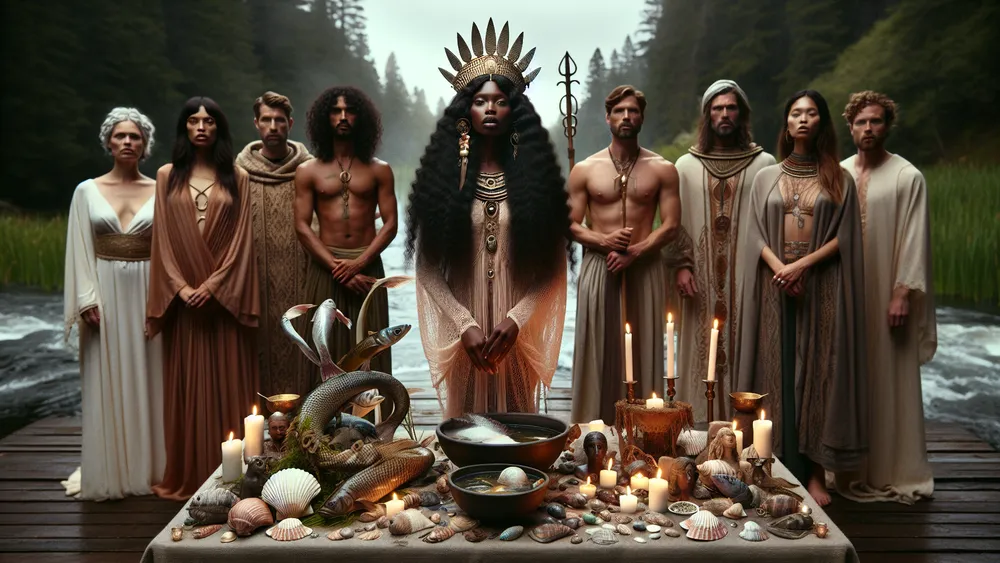
- Neo-Pagan Groups: Bring back old religious ways.
- Rituals: Focus on fertility, plenty, and water.
- Altars: Stuff like fish-shaped charms and water-related things.
Pantheon of Egyptian Mythology Gods
Maybe you are interested in learning about the big and complex group of Egyptian gods, which includes many gods and goddesses. Each one has their own special jobs and stories. This group is kind of like a big family with gods taking care of different parts of life, nature, and the universe. To see all the Egyptian gods and goddesses, you can go to this full list of the Egyptian gods.
This link will give you detailed information on each god to help you understand the complex ideas that were vital to ancient Egyptian culture.
FAQs
1. Who was Hatmehit in ancient Egyptian mythology?
Hatmehit in ancient Egyptian mythology was a goddess primarily associated with the Nile Delta and often depicted as a fish or a woman with a fish emblem.
2. What symbols are associated with Hatmehit?
The symbols associated with Hatmehit include the fish and the Nile, which represent her connection to water and fertility.
3. Where was Hatmehit primarily worshipped?
Hatmehit was primarily worshipped in the Nile Delta region, particularly in the city of Mendes.
4. How is Hatmehit represented in modern culture?
Hatmehit is represented in modern culture primarily through references in literature, art, and popular media that explore ancient Egyptian mythology.

